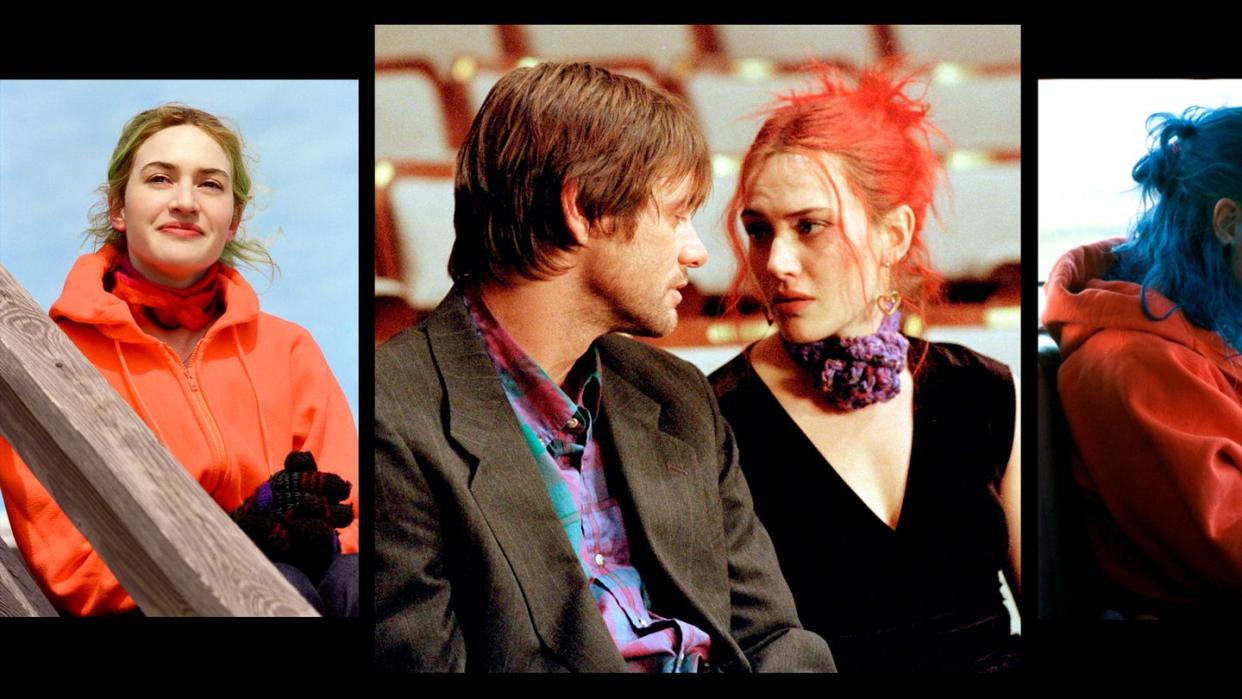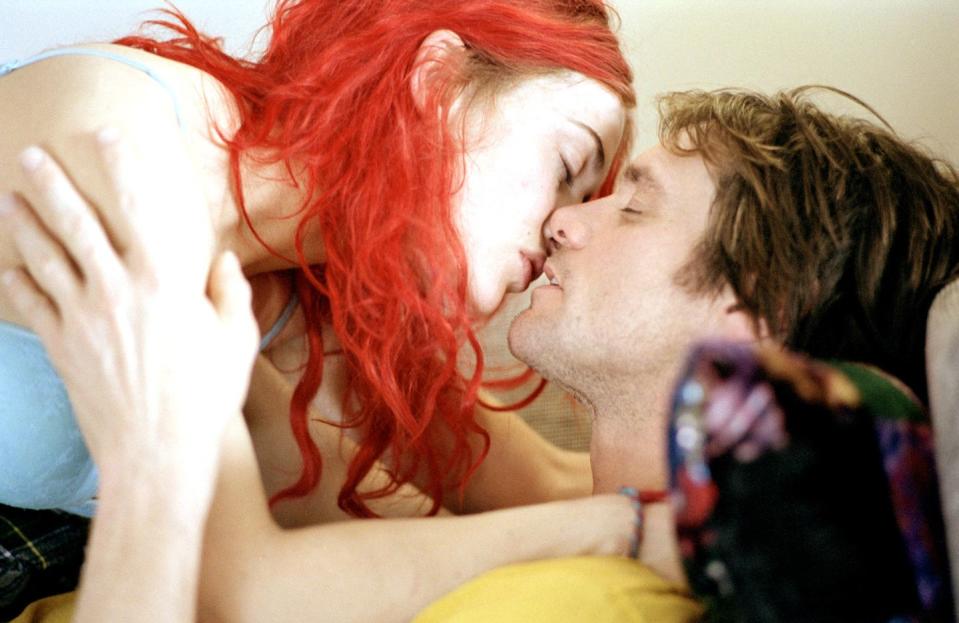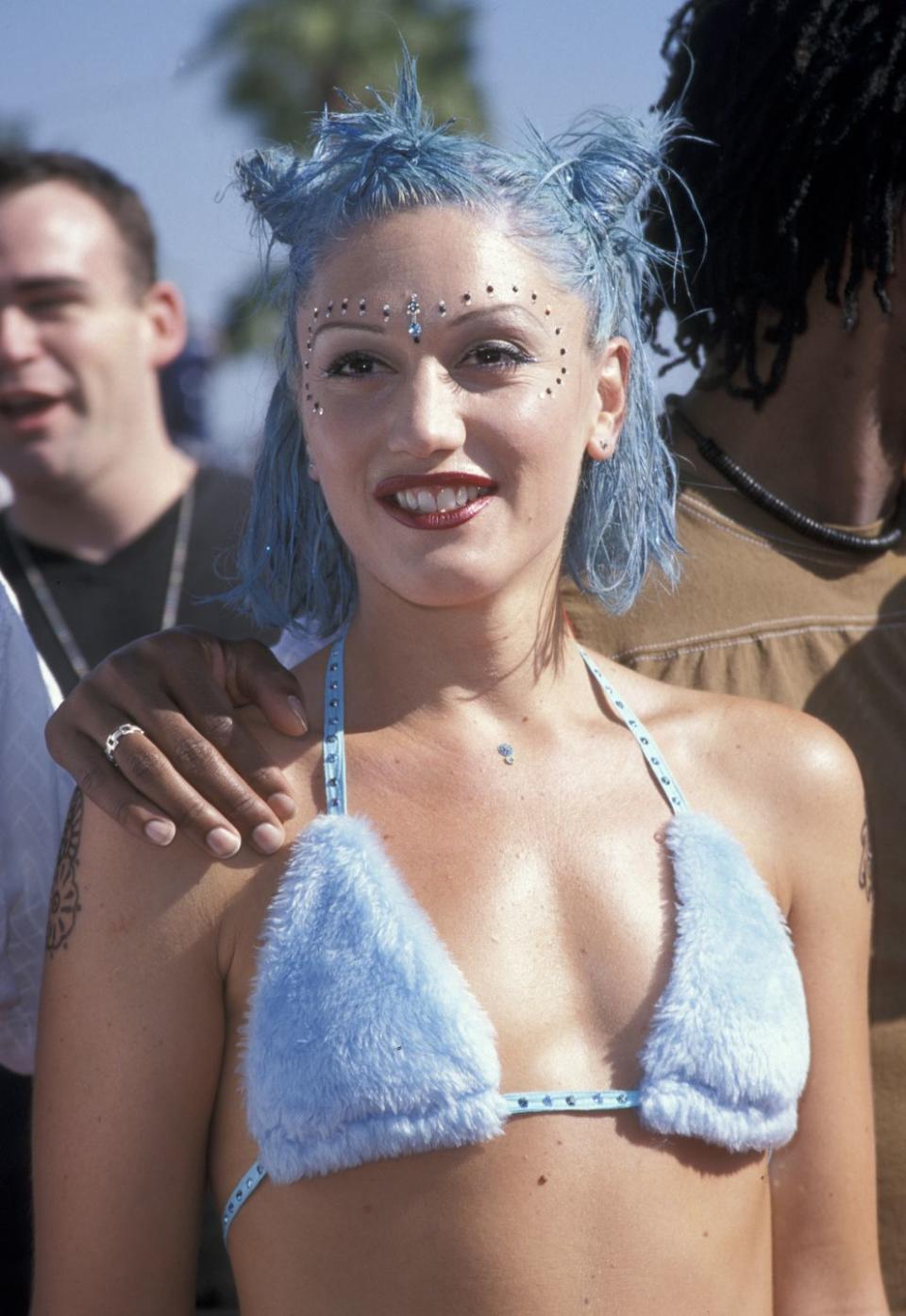We’re All Still Obsessed With the Hair in Eternal Sunshine of the Spotless Mind

- Oops!Something went wrong.Please try again later.
"Hearst Magazines and Yahoo may earn commission or revenue on some items through these links."
Kayla Casey, a hairstylist based in Los Angeles who wears her hair bright red, recently re-watched Eternal Sunshine of the Spotless Mind, a film revered for its use of unconventional hair color. “The way they portrayed hair color in the film and how they switched it up so often was so ahead of its time,” she says.
It’s been 20 years since Kate Winslet played Clementine Kruczynski, setting beauty inspiration boards on fire with her eye-catching rotation of hair colors. If you’ve never seen it, the 2004 oddball science-fictional romance stars Winslet and Jim Carrey as lovers who move forward with a medical procedure to erase all their memories of one another after a painful breakup. Clementine was brought to life onscreen by Winslet’s magnetic performance, Charlie Kaufman’s heartfelt script, and Michel Gondry’s directorial eye—but also, the artfully crafted wigs designed by Peter Owen, which resonate with fans around the globe to this day.

Even Winslet herself has a soft spot for Eternal Sunshine’s colorful hair. “Having blue hair made me feel, well, it made me feel completely rebellious,” she told Elle in 2021. “Clementine even says, ‘I apply my personality in a paste.’ It’s so true.” The film opens with Winslet wearing acidic-green hair, before her locks evolve into passionate red, electric orange, and finally, a broken-hearted blue.
Where are the wigs now? you may be wondering. “I own all of the wigs now, and my kids try them on sometimes,” Winslet said. “The reason they look so real is that they all have a natural root. And the bright pop of color was yarn dye, not hair color dye.”
Ariana Grande—freshly blonde—referenced the film for her latest album title and in the music video for new single “We Can’t Be Friends (Wait for Your Love).” So why is Clementine’s hair color still so beloved to this day? There was something undeniably cool and refreshing about how the character wore markers of her uniqueness, like her wardrobe and hair, on her sleeve like a badge of honor. Through her striking dye jobs, the character rebuffed the uniform of acceptable feminine expression. Her hair was a satisfying “what-the-fuck-ever, I’m gonna do what I want” that prioritized what felt good to her. It honored the ebb and flow of her emotional journey. The traditional boxes we’re expected to squish ourselves into with a smile in the name of social acceptability so often rob us of safety and space to explore and express pure reflections of who we are, both in the realm of beauty and far beyond it. And for that reason, Clementine’s hair, that rebellious rainbow of color and self-expression, feels like a special balm.
Haaniyah Angus, a culture writer and editor in chief of Labaatan magazine, who first saw Eternal Sunshine a few years ago, is well into her own hair-dyeing journey. “I saw this video on TikTok a couple of years ago saying that the hair color you’re meant to have isn’t necessarily always gonna be the hair color you’re born with,” says Angus, who found ginger to be her signature shade after experimenting with hues like bleached blonde, purple, fuchsia, and a mishmash of green and blue. “Ginger was the color where I actually felt like myself. I was looking at myself in the mirror like, Oh, this is who I am. I felt so much more confident than I ever had with other colors and kept trying different versions of it.”
Angus credits multi-hyphenate musician, chef, and style icon Kelis for empowering her to have fun with hair color. This creative exploration provides a sense of freedom, Angus says, and offers a glimpse into her inner world—from her mental health to the trends that are speaking to her at the moment. “I think a lot of people who have long hair go through this experience of ‘I have to keep it long, I have to keep it very healthy, I have to not touch it because it needs to grow and that’s like the ultimate symbol of femininity or whatever,’ ” Angus says. “I got to a point where I was like: It’s just hair. If I cut it, it’ll grow. If I dye it, the dye will fade. It’s just a part of my body and I should be allowed to experiment and do different things with it.”
Winslet’s character in Eternal Sunshine is described as “unhinged” and “unstable,” and it can be argued that her beauty choices simultaneously reject and play into that stereotype. There are socially acceptable ways to communicate an air of “health” through our beauty and style choices, and unnatural hair colors from a Crayola box seldom make the cut. Both onscreen and in real life, colorful hair has been misused to signal chaos, devious behavior, and mental instability.

Harley Quinn, the wildly popular DC Comics character notorious for her romance with the Joker and her love of mischief, rocks a hairstyle intended to underscore her insanity: dip-dyed bleached pigtails in shades of red and blue. Before colorful hair became known as an ordinary hair choice that could be worn by anyone, it was first adopted by punk culture, moody teens, and boundary-pushing celebrities like NBA star Dennis Rodman, musicians Björk and Gwen Stefani, and others. For many film fans, Clementine’s hair journey signaled a massive shift toward mainstream acceptance of bold hair color and laid the groundwork for a larger conversation around beauty’s role in mental health.
“I’m from Boston and even when I go back now, I definitely get a lot of looks,” Casey says. “People will say, ‘Oh, that’s an interesting choice’ or ‘Are you gonna stay like that forever?’ ”
Casey was 17 and in beauty school the first time she saw Eternal Sunshine. “I remember thinking, Wow. But I didn’t understand the true artistry of it and the different colors connected to [Clementine’s] life and emotions,” she recalls. “Seeing this woman in a film with such primary bold coloring and different tones being so comfortable with herself, and also not caring what other people had to say was affirming. It showed how free she was as a woman.”
Casey says colorful hair makes you memorable to people, especially if you’re quiet. “When I became a redhead, I finally realized who I was and my potential, because I wasn’t afraid of being a little more out-there with my own look.”
When it comes to other people contemplating dyeing their hair a bold color or doing something similar they’ve always wanted to try, Casey has a piece of advice: Take a page out of Clementine’s book—and from the vast range of women who’ve found comfort outside societal conventions—and just do it. “To see yourself differently after seeing yourself for so long with a natural hair color unlocks something so beautiful,” she says. “You morph into this hair color goddess. Don’t be afraid. Anything’s possible—just find a good colorist.”
You Might Also Like
